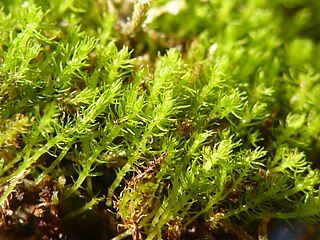
Lycopodium clavatum is the most widespread species in the genus Lycopodium in the clubmoss family.

Takakia is a genus of two species of mosses known from western North America and central and eastern Asia. The genus is placed as a separate family, order and class among the mosses. It has had a history of uncertain placement, but the discovery of sporophytes clearly of the moss-type firmly supports placement with the mosses.

The Polyporaceae are a family of poroid fungi belonging to the Basidiomycota. The flesh of their fruit bodies varies from soft to very tough. Most members of this family have their hymenium in vertical pores on the underside of the caps, but some of them have gills or gill-like structures. Many species are brackets, but others have a definite stipe – for example, Polyporus badius.
Allen Charles Skorepa was an American lichenologist, and a specialist on the lichens of Maryland. The standard author abbreviation Skorepa is used to indicate this person as the author when citing a botanical name.

Andreaea is a genus of rock mosses described by Johann Hedwig in 1801.

Tetraphidaceae is a family of mosses. It includes only the two genera Tetraphis and Tetrodontium, each with two species. The defining feature of the family is the 4-toothed peristome.
Calymperastrum latifolium is the sole species in the monotypic moss genus Calymperastrum. It is a poorly known moss, having been collected only three times. All three collections were from the trunks of Macrozamia, in the Southwest Botanic Province of Western Australia. It is presumed endemic to the region, making it the only moss genus known endemic to that state.
Ilma Grace Stone, née Balfe, was an Australian botanist who specialised in bryology. She was an author, collector, and researcher of Australian mosses, a subject on which she lectured and wrote.
Neosharpiella is a genus of moss containing two species in the family Bartramiaceae. The type species, Neosharpiella aztecorum, grows in alpine regions of central Mexico, while the other species, Neosharpiella turgida, has been found in Bolivia and Ecuador.

Hypogymnia is a genus of foliose lichens in the family Parmeliaceae. They are commonly known as tube lichens, bone lichens, or pillow lichens. Most species lack rhizines that are otherwise common in members of the Parmeliaceae, and have swollen lobes that are usually hollow. The lichens usually grow on the bark and wood of coniferous trees.
Anna Amelia Mauve was a South African botanist who worked at the Botanical Research Institute in Pretoria. She catalogued more than 4,000 plant specimens from the Kalahari and Soutpansberg regions. She made major contributions to the journals Flowering Plants of Africa and Bothalia.

Grimmia is a genus of mosses (Bryophyta), originally named by Jakob Friedrich Ehrhart in honour of Johann Friedrich Carl Grimm, a physician and botanist from Gotha, Germany.

Elizabeth Gertrude Britton was an American botanist, bryologist, and educator. She and her husband, Nathaniel Lord Britton played a significant role in the fundraising and creation of the New York Botanical Garden. She was a co-founder of the predecessor to the American Bryological and Lichenological Society. She was an activist for protection of wildflowers, inspiring local chapter activities and the passage of legislation. Elizabeth Britton made major contributions to the literature of mosses, publishing 170 papers in that field.

Itatiella ulei is a species of moss in the family Polytrichaceae. It is the only species in the genus Itatiella. The Polytrichaceae is a common family of mosses that does not have close living relatives. Its small size and the inflexed leaf apex characterize Itatiella ulei. When this species grows directly exposed to sun at high elevations, it presents a similar aspect but can be distinguished based on the distal lamella cells which are single and rhombic.

William Campbell Steere (1907–1989) was an American botanist known as an expert on bryophytes, especially arctic and tropical American species. The standard author abbreviation Steere is used to indicate this person as the author when citing a botanical name.
Petalophyllum, or petalwort, is a genus of liverworts in the order Fossombroniales.
Howard Alvin Crum was an American botanist dedicated to the study of mosses, and was a renowned expert on the North American bryoflora. The standard author abbreviation H.A.Crum is used to indicate this person as the author when citing a botanical name.
John Walter Thomson Jr. (1913–2009) was a Scottish-born American botanist and lichenologist, sometimes referred to as the "Dean of North American Lichens".
Wilfred "Wilf" Borden Schofield was a Canadian botanist, specializing in mosses and liverworts. He was considered by many "the foremost bryologist in Canada".
Paul Leslie Redfearn Jr. (1926–2018) was an American professor of botany, specializing in mosses and liverworts. He was the president of the American Bryological and Lichenological Society from 1971 to 1973. He was the mayor of Springfield, Missouri from 1978 to 1981.










